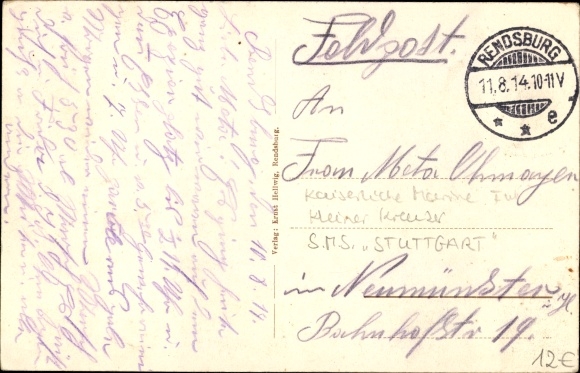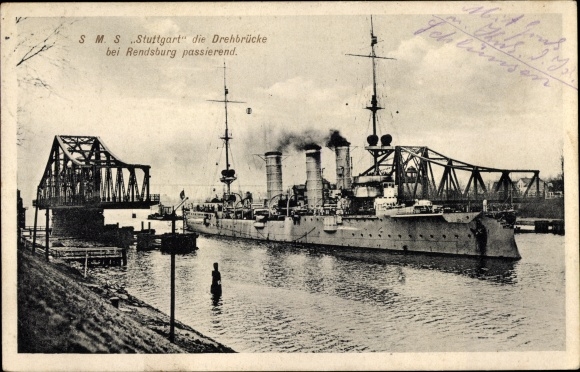By comparing the picture on glass no. 2804
[near left] with a postcard (see below) posted in 1914, the ship
depicted on the glass could be identified as the
S.M.S. Stuttgart (named for the city of
Stuttgart), a light cruiser of the Königsberg
class. The ship eponymous for the cruiser class, the
SMS Königsberg (named for the city of Königsberg,
East Prussia, today
Калининград (Kaliningrad), Russia), had her
three funnels in equally spaced positions, while the other three ships, the
Stuttgart, the
Nürnberg (named for the
city of
Nuremberg) and the
Stettin (named for the city of Stettin, today
Szczecin,
Poland), had their aft funnel placed at a somewhat larger space behind the forward two funnels.
The
Stuttgart was built in 1906 at the Imperial Shipyard in Danzig (today
Gdańsk, Poland) and was
commissioned in 1908; in 1918 the ship was converted to a seaplane tender housing three sea planes, one on deck and two in hangars.
In 1920 the
Stuttgart was surrendered to Great Britain where she was broken up in the same year.

 Souvenir glasses like those of this collection were frequently made based on the pictures on postcards of the time. The picture was copied and transfered to
the glass using a transfer print, which then was coloured by hand.
Compare glass no. 2804 [near left] with a postcard with the identical design [right] (see external
link).
Souvenir glasses like those of this collection were frequently made based on the pictures on postcards of the time. The picture was copied and transfered to
the glass using a transfer print, which then was coloured by hand.
Compare glass no. 2804 [near left] with a postcard with the identical design [right] (see external
link).
|
|
"S.M.S. Wettin"
Glass no. 2335: In this collection allocated to: Rendsburg

|
The SMS Wettin was built in 1899–1901 at the Schichau shipyards in Danzig (now Gdańsk).
Launched in 1901 she was commissioned in 1902.
The battleship of the Wittelsbach Class had a length of 125 metres, a width of 21 metres and a draught of 7.7 metres.
The ship had a displacement of 12,596 tons and sailed at a speed of 17.5 knots, her crew was ca. 680 men. With the launch of the
HMS Dreadnought in 1906, this type of ship essentially became outdated. The Wettin served with the fleet until 1911 when she became an
artillery training ship until 1914. In 1916 the Wettin was disarmed and soon after became an accomodation and tender at Wilhelmshaven.
In 1922 the Wettin was finally scrapped at Rönnebeck (today part of Bremerhaven). The ships's bell is in the army museum at
Dresden.
| |

